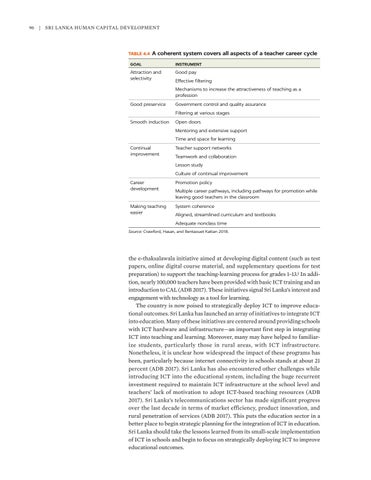96 | Sri Lanka Human Capital Development
TABLE 4.4 A
coherent system covers all aspects of a teacher career cycle
GOAL
INSTRUMENT
Attraction and selectivity
Good pay Effective filtering Mechanisms to increase the attractiveness of teaching as a profession
Good preservice
Government control and quality assurance Filtering at various stages
Smooth induction
Open doors Mentoring and extensive support Time and space for learning
Continual improvement
Teacher support networks Teamwork and collaboration Lesson study Culture of continual improvement
Career development
Promotion policy
Making teaching easier
System coherence
Multiple career pathways, including pathways for promotion while leaving good teachers in the classroom Aligned, streamlined curriculum and textbooks Adequate nonclass time
Source: Crawford, Hasan, and Bentaouet Kattan 2018.
the e-thaksalawala initiative aimed at developing digital content (such as test papers, online digital course material, and supplementary questions for test preparation) to support the teaching-learning process for grades 1–13.1 In addition, nearly 100,000 teachers have been provided with basic ICT training and an introduction to CAL (ADB 2017). These initiatives signal Sri Lanka’s interest and engagement with technology as a tool for learning. The country is now poised to strategically deploy ICT to improve educational outcomes. Sri Lanka has launched an array of initiatives to integrate ICT into education. Many of these initiatives are centered around providing schools with ICT hardware and infrastructure—an important first step in integrating ICT into teaching and learning. Moreover, many may have helped to familiarize students, particularly those in rural areas, with ICT infrastructure. Nonetheless, it is unclear how widespread the impact of these programs has been, particularly because internet connectivity in schools stands at about 21 percent (ADB 2017). Sri Lanka has also encountered other challenges while introducing ICT into the educational system, including the huge recurrent investment required to maintain ICT infrastructure at the school level and teachers’ lack of motivation to adopt ICT-based teaching resources (ADB 2017). Sri Lanka’s telecommunications sector has made significant progress over the last decade in terms of market efficiency, product innovation, and rural penetration of services (ADB 2017). This puts the education sector in a better place to begin strategic planning for the integration of ICT in education. Sri Lanka should take the lessons learned from its small-scale implementation of ICT in schools and begin to focus on strategically deploying ICT to improve educational outcomes.




